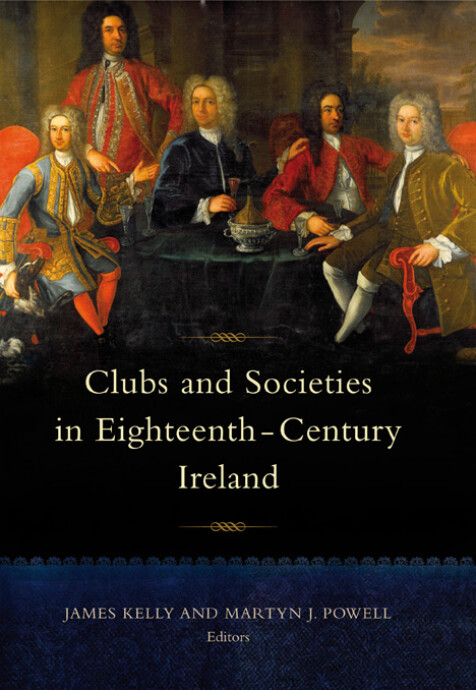Clubs and societies in eighteenth-century Ireland
James Kelly & Martyn J. Powell, editors
'Tightly edited and effectively showcases the current health of eighteenth-century Irish history … it is a major work of social history and a significant intervention in the growing international literature on the associational impulse. It presents important insights which should inform the interrelated and contentious debates about the nature of sociability and the applicability of concepts of a public sphere and civil society to Irish history', Liam Chambers, Irish Historical Studies (November 2012).
‘This collection offers the most complete, comprehensive and up-to-date consideration of clubs and societies, and of associational behaviour, that is available for 18th-century Ireland … readers will find this work an enjoyable, fascinating and very informative discussion which brings together the writings of a large group of scholars in a coherent and focused manner', Charles Ivar McGrath, EHR (August 2012).
‘This book deals with a growth area, described as “associational culture”, or what has over a longer period in France been recognised as sociabilité. Happily the terms do not occur too often in the volume which is less an analytical one and more a collection of articles based on solid research on a wide range of sources, about men (and much more rarely women) coming together in societies and clubs. In some 500 pages there are twenty-two contributions from sixteen authors, including four from each editor. The editors have structured the volume carefully and it has been tightly edited … Three societies stand out in historical study: the Dublin Philosophical Society of 1683, the Dublin Society, and the Royal Irish Academy … The Dublin Hellfire Club and the Aldermen of Skinner’s Row are the subject of full analysese by David Ryan and Martyn Powell respectively … the Monks of the Screw and The Friends of the Constitution receive highly informative treatment … Quite apart from the instructive use of the newspapers as a source, the volume is essential reading for any serious student of the century. The fact that sixteen authors could be brought together in a series of very detailed studies is itself a measure of the growth in depth of research in Irish history of the period. The volume is particularly rich on the late eighteenth century', Louis M. Cullen, Irish Economic and Social History (2011).
‘The essays collected here represent a notable achievement and will set the agenda for all future research on associational culture, civil society and the public sphere in eighteenth-century Ireland. Clubs and Societies offers the first comprehensive overview of this associational culture and brings into sharp focus a clubbable world that, in most instances, was known only in its broad outlines … the essays are uniformly excellent … [an] important collection', Padhraig Higgins, Irish Studies Review (November 2011).
‘This volume establishes beyond any reasonable doubt the nature, density and vibrancy of eighteenth-century Irish associational life … Perhaps the most important sections of this volume are the fourth and fifth which discuss convivial, sociable and sporting societies and regional associational life. These sections go furthest toward fulfilling the aspiration to reveal the contribution of association to creating a particular kind of society in Ireland … Toby Barnard’s analysis of the work of the Dublin Society stands out as a sophisticated yet detailed account of the most prominent Irish association of the eighteenth-century', James Livesey, Eighteenth-Century Ireland (2011).
‘This collection of essays by distinguished scholars and prominent historians in their respective fields can be seen as breaking new ground. Issues such as the transformation of societies into variants of democratic governance; the sharp distinction between private life and emerging public sphere; the apparent omission of women and, of course, the absence of Irish Catholics from the physical public sphere and its imagine equivalent, are amongst the matters discussed in a very accessible manner by the contributors … this book is a fascinating and very illuminating read which is highly recommended as it should be of particular interest to the genealogist, social and local historian', Micheal Merrigan, Ireland’s Genealogical Gazette (February 2011).

